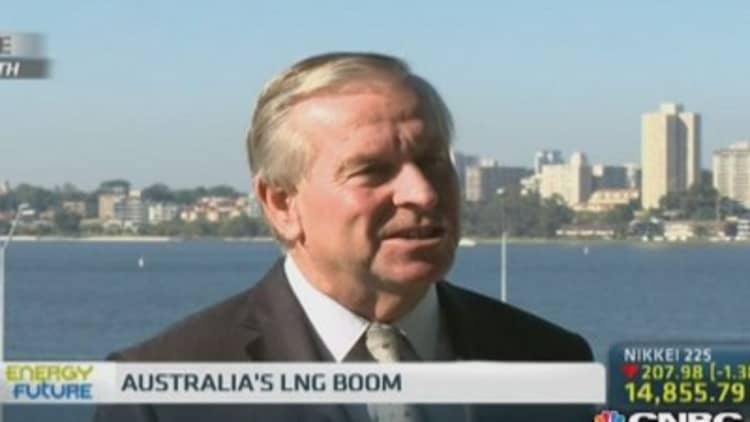Australia, home to the world's seventh largest recoverable shale gas reserves, has several characteristics conducive for commercializing the resource including existing infrastructure, industry know-how and low population density in shale-rich regions.
So, what is the potential for a U.S.-like shale revolution in the country?
Australia has an estimated 437 trillion cubic feet of recoverable shale gas reserves, according to the Energy Information Administration (EIA), around two-thirds of the U.S.'s 665 trillion cubic feet – the world's fourth largest – and two-fifths of China's 1,115 trillion cubic feet – the world's largest.
Read MoreAustralia's next wave of energy investment under threat
"Broadly most people would recognize Australia is the closest analogy [to the U.S.], with our infrastructure position and unconventional shale gas opportunities," James Baulderstone, vice president, Eastern Australia at oil and gas firm Santos, told CNBC.
The Australian shale gas industry is still in its infancy, but exploration has increased in the last few years. The sector has been drawing international interest from global players. The likes of Chevron, ConocoPhillips, Statoil, Total, BG Group, have invested over $1.55 billion in Australia's shale gas industry as of mid-2013, according to EIA.

Santos is among a group of Australian companies developing shale properties in the country. It launched the country's first commercial shale gas well near its conventional gas activities in the Cooper Basin in South Australia, in 2012. There is currently limited commercial shale gas production in Australia, however.
Industry analysts say while Australia's shale sector holds promise, its challenges are very different to the U.S in terms of production costs, the onshore service industry and the regulatory environment - which could constrain the industry's potential.
"I think it's probably harder in Australia than it is in the U.S. for a number of reasons," said Alex Wonhas, executive director, energy and resources at Commonwealth Scientific and Industrial Research Organisation (CSIRO).
For starters, developing shale resources in Australia is costlier than in the U.S., Wonhas noted.
In Australia, several basins are located in remote parts of the country. While this may mean less environmental opposition, these areas would require significant investments in pipeline and processing infrastructure.
While the infrastructure in the Cooper Basin is reasonably good, there are no pipelines connecting the Canning, Georgina, Pedrika and Officer basins to the existing main transmission lines, according to the University College London (UCL) International Energy Policy Institute. Pipelines are seen as the most effective means of transporting gas directly to either consumers or a liquefied natural gas (LNG) terminal.
Furthermore, the capacity of Australia's service industry in terms of drilling and hydraulic fracturing services is not adequate, say experts.
"In Australia, there's limited service sector availability, in terms of fracking crews and high specification rigs that can drill deep into the shales," said Chris Graham, head of Australasia upstream research at Wood Mackenzie.
Read More Swan to Hockey: Stop talking down Australia's economy
Shale gas drilling and fracking are over three times as costly as in the U.S., according to industry estimates.
Another key difference is the regulatory environment, in particular the mineral rights ownership, say industry participants.
In the U.S., landowners possess the rights to the resources beneath their land and are entitled to royalties. This has ensured local communities are able to benefit financially, thus helping to temper local opposition to the industry.
In Australia, the state owns any underground resources. Australian landholders have to provide access, in return for some compensation, to energy companies that want to explore and exploit their land. The proceeds are generally not as large as U.S. royalty payments, according to mining and energy corporate advisory RFC Ambrian, so there is less incentive for landholders to encourage minerals development on their properties.
Factors such as mineral rights ownership may slow down the development of the Australia's shale deposits, said Pal Haremo, vice president, exploration at Norwegian oil and gas company Statoil, which has invested in shale acreage in the country with Canada's PetroFrontier.
"It's not just about the quality of the rock, it's also about commercial terms, politics. The U.S. has a fantastic system where landowners own the minerals, so there's a win-win. But the U.S. system is very unique," Haremo said.
Read More Give China credit on yuan: Australian Treasurer
Finally, there remains a great deal of uncertainty around the quality of Australia's shale resource as reserves haven't been tapped in a big way yet, making investing in the sector a high risk proposition.
"Just because you've understood a play in the U.S., it doesn't mean you can necessarily translate that into an Australia play. You can only understand it by drilling it and producing it to see what the drop off in production is. And that's very location and shale specific," said Graham of Wood Mackenzie.
This year, some clarity will begin to emerge as a number of companies with will publish flow test results from their shale wells, which will provide an indication of their production potential.
As such, Graham says it may be too early to draw conclusions about the industry's potential.
"We're so early in the day. There have been some positive results in some areas, but slow progress in others. It's really too early to tell," he said.





